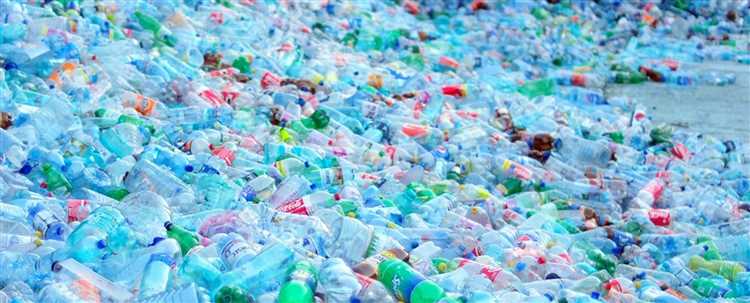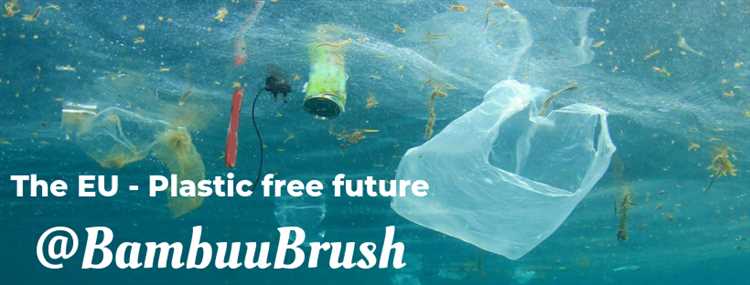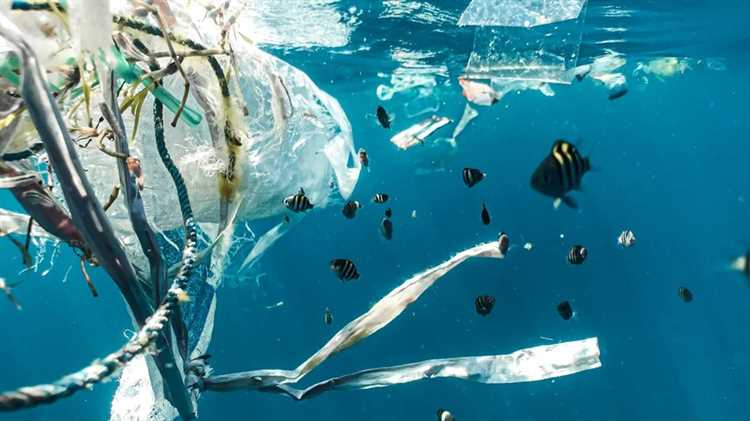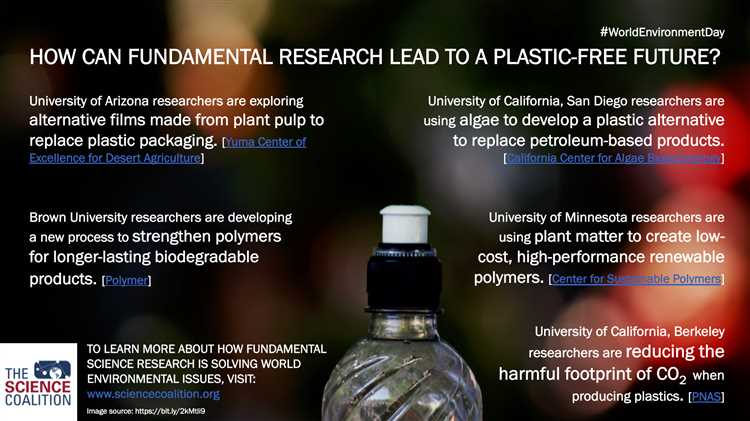
In recent years, there has been growing concern about the impact of plastic on our environment. Plastic pollution is a global problem that affects not only our ecosystems but also human health. As we continue to produce and consume more plastic, it is becoming clear that we need to find alternative solutions to reduce our dependency on this harmful material.
One possibility is a plastic-free future. Imagine a world where single-use plastic is a thing of the past, and sustainable alternatives are readily available. It may seem like a lofty goal, but it is one that is increasingly being pursued by individuals, businesses, and governments around the world.
To achieve a plastic-free future, we need a multi-faceted approach. This includes reducing plastic production, improving recycling and waste management systems, and promoting the use of biodegradable and eco-friendly materials. It also requires a shift in consumer behavior, with individuals making conscious choices to reduce their plastic consumption and support plastic-free alternatives.
While it may be challenging, there are already promising signs of progress. Many countries have implemented plastic bans or restrictions on single-use plastics, and companies are innovating to develop sustainable packaging solutions. Additionally, public awareness about the environmental impacts of plastic is growing, prompting more individuals to adopt plastic-free lifestyles.
However, achieving a plastic-free future will require collaboration and collective action. It is not enough for a few individuals or businesses to make changes – we need widespread systemic change to truly make a difference. By working together, we can create a future where plastic pollution is a thing of the past and our planet can thrive for generations to come.
- The Global Plastic Crisis
- Pollution and Environmental Impact
- Health Risks and Concerns
- 1. Chemical Leaching
- 2. Microplastics Ingestion
- 3. Environmental Pollution
- The Importance of Reducing Plastic Consumption
- 1. Environmental Impact
- 2. Human Health Concerns
- Individual Responsibility
- Educating Yourself
- Reducing Single-Use Plastics
- Proper Waste Management
- Government and Businesses Initiatives
- Alternatives to Plastic
- Natural and Biodegradable Materials
- Another natural material is hemp.
- undefined
- What are the major challenges in achieving a plastic free future?
- How can individuals contribute to a plastic free future?
- Are there any alternatives to plastic that can be widely used?
- What steps are being taken by businesses and governments to reduce plastic waste?
- Is it realistic to achieve a plastic free future?
The Global Plastic Crisis
The world is currently facing a global plastic crisis. The production and consumption of plastic have reached unsustainable levels, resulting in severe environmental and health consequences.
Plastic pollution is a major threat to our oceans, marine life, and terrestrial ecosystems. Every year, millions of tons of plastic waste end up in the oceans, harming marine animals and degrading their habitats. The plastic waste often breaks down into microplastics, which are tiny particles that can be ingested by marine organisms and enter the food chain.
In addition to harming marine life, plastic pollution also affects human health. Plastic particles and chemicals can leach into the environment, contaminating drinking water sources and agricultural lands. Studies have found that humans are exposed to microplastics through food, air, and water, with potential health risks including reproductive issues, hormonal disruptions, and even cancer.
The global plastic crisis also contributes to climate change. The production of plastic requires fossil fuels, leading to greenhouse gas emissions and the depletion of natural resources. Furthermore, the improper disposal and incineration of plastic waste release toxic gases and contribute to air pollution.
To tackle the global plastic crisis, international cooperation and individual efforts are crucial. Governments and businesses must prioritize the development and implementation of sustainable alternatives to plastic, such as biodegradable materials and reusable products. Education and awareness campaigns can also play a significant role in changing consumer behavior and reducing plastic consumption.
In conclusion, the global plastic crisis poses significant challenges to our planet and well-being. However, by taking collective action and adopting sustainable practices, we can work towards a plastic-free future and protect the environment for future generations.
| Effects of Plastic Pollution | Solutions |
|---|---|
| – Harm to marine life and ecosystems | – Development of biodegradable materials |
| – Contamination of water sources | – Promotion of reusable products |
| – Health risks to humans | – Education and awareness campaigns |
| – Contribution to climate change | – International cooperation |
Pollution and Environmental Impact
One of the biggest issues surrounding the use of plastic is its negative impact on the environment. The production, consumption, and disposal of plastic items contribute to pollution in various ways.
Plastic pollution is a significant problem in oceans and waterways. According to studies, around 8 million metric tons of plastic waste enter the oceans every year. This pollution not only affects marine life but also disrupts entire ecosystems. Sea turtles, dolphins, and whales often mistake plastic bags and other items for food, leading to their injury or death. Additionally, plastic particles can enter the food chain, posing a risk to human health as well.
Land pollution is another consequence of plastic waste. Many plastic items, such as bags and bottles, end up in landfills where they take hundreds of years to decompose. As a result, these landfills become breeding grounds for harmful bacteria and pests. Moreover, the burning of plastic releases toxic pollutants into the air, contributing to air pollution and climate change.
Furthermore, the production of plastic involves the extraction and processing of fossil fuels, which are non-renewable resources. This process leads to the emission of greenhouse gases and contributes to global warming. Additionally, the chemicals used in plastic production can have long-term effects on human health and the environment, especially when the plastic is not properly disposed of or recycled.
To address these concerns, countries and organizations have implemented initiatives to reduce plastic pollution and its environmental impact. These efforts include recycling programs, bans on single-use plastics, and the development of alternative materials. However, achieving a plastic-free future requires collective action and a shift towards sustainable practices that prioritize the environment over convenience.
| Type of Pollution | Environmental Impact |
|---|---|
| Marine Pollution | Disrupts ecosystems, threatens marine life, enters the food chain |
| Land Pollution | Creates pollution in landfills, releases toxic pollutants when burned |
| Resource Depletion | Uses non-renewable fossil fuels, emits greenhouse gases, contributes to global warming |
| Health Impacts | Long-term effects of chemicals, risks to human health when plastic is not properly disposed or recycled |
Health Risks and Concerns

As the amount of plastic waste in our environment continues to increase, so do the health risks and concerns associated with it. Plastics contain various chemicals, many of which have been linked to negative health effects in humans.
1. Chemical Leaching
One of the main concerns is the leaching of chemicals from plastic products into our food and drinks. When plastic comes into contact with hot liquids or acidic foods, such as coffee or tomatoes, harmful chemicals like bisphenol A (BPA) and phthalates can be released. These chemicals have been shown to disrupt hormones and have been linked to a range of health issues, including reproductive problems and certain types of cancer.
2. Microplastics Ingestion
An emerging concern is the ingestion of microplastics, tiny pieces of plastic that can be found in the air, water, and food. These microplastics have been found in various marine species, drinking water, and even the air we breathe. When ingested, they can accumulate in our bodies and potentially cause inflammation, oxidative stress, and cellular damage. Furthermore, they can act as carriers for toxic chemicals and bacteria, posing additional health risks.
Studies have shown that microplastics can penetrate the gut lining, enter the bloodstream, and accumulate in vital organs. This has raised concerns about the long-term health effects of microplastic exposure, including potential impacts on the immune system, reproductive system, and overall well-being.
3. Environmental Pollution
Plastic pollution also has indirect health impacts through environmental pollution. Plastic waste can introduce harmful chemicals and toxins into ecosystems, which can then enter the food chain. As humans consume seafood and other products from contaminated ecosystems, they may be exposed to these pollutants, leading to adverse health effects.
Furthermore, the accumulation of plastic waste in the environment can contribute to the spread of disease. Plastic debris can act as a breeding ground for bacteria, increasing the risk of infection and disease transmission.
In conclusion, the health risks and concerns associated with plastic waste are significant. It is crucial to reduce plastic consumption, find alternative materials, and improve waste management practices to protect human health and the environment.
The Importance of Reducing Plastic Consumption

Plastic consumption has been on the rise for several decades, leading to a global environmental crisis. The impact of plastic pollution on ecosystems and human health cannot be ignored. It is essential to understand the importance of reducing plastic consumption and finding sustainable alternatives.
1. Environmental Impact
Plastic pollution has devastating effects on the environment. Plastic waste often ends up in our oceans, where it harms marine life. Sea turtles, birds, and other animals can mistake plastic for food and suffer from starvation or physical injuries. Moreover, the breakdown of plastic materials creates microplastics that are easily consumed by marine organisms, entering the food chain and potentially harming human health.
Plastic production also contributes to the emission of greenhouse gases and the depletion of natural resources. The extraction and manufacturing processes of plastic require fossil fuels, contributing to carbon emissions and climate change. By reducing plastic consumption, we can help mitigate these negative environmental impacts and protect our planet.
2. Human Health Concerns
Plastic consumption not only affects the environment but also poses risks to human health. Chemicals in plastic, such as phthalates and bisphenol A (BPA), have been linked to various health issues, including hormonal disorders, reproductive problems, and cancer. These chemicals can leach out of plastic containers and bottles into food and beverages, contaminating our diet.
Reducing plastic consumption can minimize our exposure to these harmful chemicals and promote a healthier lifestyle for ourselves and future generations. By choosing reusable alternatives like stainless steel water bottles or glass containers, we can avoid the potential health risks associated with plastic.
| Benefits of Reducing Plastic Consumption: |
|---|
| 1. Preservation of marine ecosystems |
| 2. Decreased carbon emissions |
| 3. Conservation of natural resources |
| 4. Protection of human health |
| 5. Promotion of sustainable living |
In conclusion, reducing plastic consumption is vital for the well-being of our planet and ourselves. By understanding the environmental impact and health concerns associated with plastic, we can make informed choices and adopt sustainable alternatives. Together, we can work towards a plastic-free future and create a cleaner, healthier world for future generations.
Individual Responsibility
While governments and organizations play an essential role in enacting policies and regulations to reduce plastic waste, individuals also have a significant responsibility in achieving a plastic-free future. Every person can make a difference by making conscious choices, adopting sustainable habits, and being mindful of their consumption and waste management.
Educating Yourself
Becoming informed about the environmental impact of plastic pollution is crucial to inspire change in individual behavior. By staying up to date with the latest scientific research and developments, individuals can better understand the urgency of the issue and the potential consequences of continued plastic use. Taking the time to educate oneself about alternative materials and sustainable practices enables individuals to make more informed choices.
Reducing Single-Use Plastics
One of the most effective ways individuals can contribute to a plastic-free future is by reducing their use of single-use plastics. This can be achieved by investing in reusable alternatives such as water bottles, coffee cups, and shopping bags. By actively seeking out products with minimal packaging and avoiding disposable items, individuals can greatly reduce their plastic footprint.
Additionally, individuals can make a significant impact by avoiding the use of plastic straws, cutlery, and takeout containers whenever possible. Opting for environmentally friendly alternatives like metal or bamboo straws, reusable cutlery, and bringing your own food containers for takeout can significantly reduce the amount of plastic waste generated.
Proper Waste Management

Individuals should also take responsibility for proper waste management to prevent plastic pollution. This includes recycling plastic items where available and disposing of them in designated recycling bins. However, it is important to note that recycling should not be seen as a magic solution, as it has limitations and relies on efficient infrastructures. Therefore, individuals should prioritize reducing and reusing before resorting to recycling.
Furthermore, individuals should be mindful of their personal consumption habits and strive to minimize overall waste generation. This can be achieved by practicing mindful shopping, reducing unnecessary purchases, and repurposing or donating items instead of simply throwing them away.
In conclusion, individual responsibility plays a crucial role in achieving a plastic-free future. By educating themselves, reducing single-use plastics, and practicing proper waste management, individuals can make a significant contribution in reducing plastic waste and creating a more sustainable world.
Government and Businesses Initiatives
In recent years, there has been a growing recognition of the need to address the issue of plastic waste. Governments and businesses around the world have taken various initiatives to reduce plastic consumption and promote a plastic-free future.
Many countries have implemented regulations and policies to discourage the use of single-use plastics. For example, some have imposed taxes on plastic bags or banned the use of certain types of plastic products altogether. These efforts aim to change consumer behavior and encourage the use of more sustainable alternatives.
Furthermore, governments have started investing in research and development of innovative solutions to tackle plastic pollution. This includes funding studies on new materials, as well as supporting projects that aim to develop biodegradable and compostable packaging options.
Businesses have also recognized the importance of reducing their plastic footprint and have implemented various initiatives to achieve this. Many companies have made commitments to eliminate or reduce the use of single-use plastics in their operations. They have started exploring alternative materials, such as plant-based plastics, and have invested in recycling and waste management infrastructure.
In addition, businesses have launched awareness campaigns to educate consumers about the environmental impact of plastic waste. They have encouraged individuals to make more sustainable choices, such as using reusable bags and bottles, and have introduced recycling programs to facilitate the proper disposal of plastic products.
| Government Initiatives | Business Initiatives |
|---|---|
| Implemented regulations and policies to discourage the use of single-use plastics | Commitments to eliminate or reduce the use of single-use plastics in operations |
| Investment in research and development of innovative solutions to tackle plastic pollution | Exploration of alternative materials, such as plant-based plastics |
| Funding studies on new materials and supporting projects for biodegradable and compostable packaging | Investment in recycling and waste management infrastructure |
| Launch of awareness campaigns to educate consumers about the environmental impact of plastic waste |
In conclusion, governments and businesses have taken significant steps towards a plastic-free future. Through regulations, investments, and awareness campaigns, they are working together to reduce plastic consumption and promote sustainable alternatives.
Alternatives to Plastic
As the negative impact of plastic on the environment becomes more evident, finding alternatives to plastic has become a pressing matter. Luckily, there are several options available that can help reduce our reliance on plastic.
| Material | Advantages | Disadvantages |
|---|---|---|
| Glass | Durable, reusable, and recyclable | Heavy and can break easily |
| Metal | Durable, long-lasting, and recyclable | Can be expensive and prone to dents |
| Bamboo | Renewable, biodegradable, and lightweight | May require transportation over long distances |
| Paper | Recyclable and biodegradable | Not as durable as plastic |
| Cotton | Biodegradable, reusable, and natural | May require pesticides during cultivation |
These alternatives can be used in various ways, such as packaging, utensils, and household items. By choosing these alternatives, we can significantly reduce the amount of plastic waste that ends up polluting our oceans and landfills. However, it is important to note that no alternative is perfect, and each has its own set of advantages and disadvantages. Therefore, it is essential to consider the specific needs and limitations of each alternative when determining the best option.
In conclusion, while a plastic-free future may seem challenging, there are viable alternatives that can help us move away from our dependence on plastic. By exploring and utilizing these alternatives, we can take significant steps towards a more sustainable and environmentally-friendly future.
Natural and Biodegradable Materials
Natural and biodegradable materials are playing an important role in the quest for a plastic-free future. These materials are derived from natural sources and can break down over time, without harming the environment. By replacing plastic with natural alternatives, we can significantly decrease the amount of waste generated and reduce our reliance on fossil fuels.
One example of a natural and biodegradable material is cotton. Cotton is a versatile and widely used material that can be used in a variety of applications, such as clothing, bags, and packaging. It is renewable, as it is derived from the cotton plant, and can also be composted at the end of its life cycle. Additionally, cotton is breathable and comfortable, making it a popular choice for consumers.
Another natural material is hemp.
Hemp is a fast-growing plant that requires minimal pesticides and water to cultivate. Like cotton, hemp can be used to make a wide range of products, including textiles, paper, and bioplastics. Hemp is not only biodegradable but also has a smaller carbon footprint than many other materials. Its cultivation also has environmental benefits, such as improving soil health and reducing the need for chemical fertilizers.
One of the most promising biodegradable materials is bioplastics. These plastics are derived from renewable sources, such as cornstarch or sugarcane, and can break down naturally over time. Bioplastics can be used for a variety of purposes, including packaging, cutlery, and disposable items. While they still have some limitations, such as higher production costs and limited availability, research and development in this field are progressing rapidly.
Other natural and biodegradable materials include bamboo, which is a sustainable alternative to wood and can be used in construction and furniture, and agricultural waste, which can be repurposed into materials like biochar or biogas.
In conclusion, natural and biodegradable materials offer promising solutions in our journey toward a plastic-free future. By embracing these alternatives, we can reduce the negative environmental impact of plastic waste while still meeting our needs for everyday products.
undefined
What are the major challenges in achieving a plastic free future?
The major challenges in achieving a plastic free future include the excessive use of single-use plastics, limited recycling capabilities, and the lack of awareness and action by individuals and businesses.
How can individuals contribute to a plastic free future?
Individuals can contribute to a plastic free future by reducing their consumption of single-use plastics, opting for reusable alternatives, recycling properly, and supporting initiatives that aim to reduce plastic waste.
Are there any alternatives to plastic that can be widely used?
Yes, there are various alternatives to plastic that can be widely used, such as biodegradable plastics, paper and cardboard packaging, glass containers, and reusable materials like stainless steel or bamboo.
What steps are being taken by businesses and governments to reduce plastic waste?
Many businesses and governments are taking steps to reduce plastic waste, including implementing plastic bag bans, promoting recycling initiatives, investing in research and development of alternative materials, and encouraging sustainable packaging practices.
Is it realistic to achieve a plastic free future?
While achieving a completely plastic free future may be challenging, it is realistic to significantly reduce our dependence on plastic and promote more sustainable alternatives. With collective effort from individuals, businesses, and governments, we can make a significant difference in reducing plastic waste.